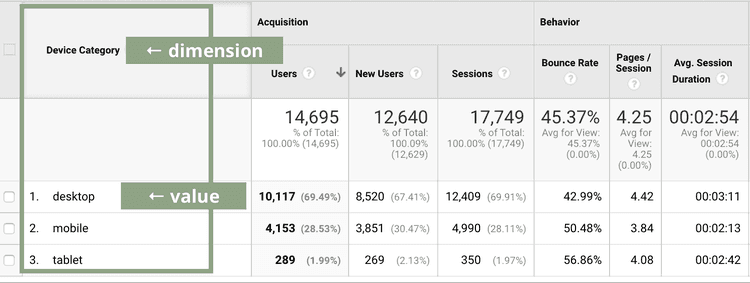Understanding the Concept of a 'Secondary Dimension' in Google Analytics: What Does It Mean?
Understanding the Concept of a 'Secondary Dimension' in Google Analytics: What Does It Mean?
Blog Article
Browsing the Depths of Secondary Dimension in Google Analytics: A Detailed Expedition on Its Functionality
In the realm of digital analytics, the details of data analysis usually hold the key to opening beneficial understandings. Within the expansive toolkit of Google Analytics lies a function that works as a hidden treasure for those that seek a deeper understanding of individual actions and web site performance. Second measurements, though apparently straightforward at very first glance, harbor a wide range of untapped prospective waiting to be utilized. As we start this trip to check out the nuanced functionality of additional measurements, we will certainly discover exactly how this feature can brighten patterns, introduce correlations, and inevitably lead the way for notified decision-making in the electronic landscape.
Understanding Secondary Measurements in Google Analytics

Recognizing how secondary measurements work is important for leveraging the complete power of Google Analytics. By incorporating primary metrics with additional dimensions, you can get important understandings that drive informed decision-making and optimization methods.
Leveraging Additional Measurements for Data Evaluation
Structure upon the foundational understanding of just how additional measurements boost data evaluation in Google Analytics, the utilization of these extra layers of details ends up being vital in extracting valuable understandings for educated decision-making and optimization techniques. By leveraging secondary measurements, experts can delve much deeper right into the efficiency metrics by adding even more context to the key measurements, therefore revealing concealed patterns and connections that may not be obvious initially look. This much deeper level of evaluation makes it possible for services to much better comprehend user actions, recognize fads, and determine areas for improvement.
Moreover, additional dimensions provide an even more detailed view of the data, enabling for segmentation based upon numerous specifications such as demographics, gadgets, traffic sources, and much more. This division facilitates a more granular evaluation, making it possible for organizations to tailor their strategies and projects to particular audience segments for boosted targeting and personalization. In essence, the tactical use additional dimensions empowers companies to make data-driven choices that drive growth and success in the electronic landscape.
Advanced Strategies for Secondary Measurement Execution
Checking out intricate approaches to harness the full potential of secondary dimensions in Google Analytics boosts the deepness and elegance of data evaluation for critical decision-making. One innovative method for carrying out additional dimensions is the use of custom measurements. Additionally, incorporating second dimensions with advanced sectors can provide even extra granular insights by applying several layers of segmentation to the information.
Interpreting Insights Through Secondary Measurements

When interpreting understandings through secondary measurements, it is crucial to think about the context of the why not check here information and exactly how various dimensions communicate with each other. For instance, understanding which specific web traffic sources cause greater conversion prices or determining which tools customers like for making purchases can provide actionable understandings for enhancing advertising campaigns and boosting general website efficiency. By meticulously taking a look at the data with additional measurements in mind, services can make enlightened decisions that drive purposeful outcomes and boost their digital existence.
Maximizing Efficiency With Second Dimensions

One key way to visit this site enhance efficiency with additional dimensions is by segmenting data a lot more granularly. This enables you to isolate details factors that might be affecting your metrics and obtain a far better understanding of what drives success or failure in your electronic campaigns. For instance, by integrating secondary measurements such as 'device classification' and 'touchdown page,' you can pinpoint which device types are most effective for certain landing pages, enabling you to customize your methods as necessary.
Additionally, utilizing second dimensions can aid you identify patterns, patterns, and connections that might not be evident when assessing data with primary measurements alone. This much deeper level of evaluation can cause even more enlightened decision-making and ultimately enhance the total performance of your web site or electronic advertising and marketing campaigns.
Verdict
Finally, additional dimensions in Google Analytics play an essential role in boosting information evaluation and giving deeper insights into website performance. By making use of innovative techniques and translating the data properly, companies can enhance their methods and enhance total efficiency. Recognizing the performance of secondary measurements is necessary for making notified decisions and driving success in the digital landscape.
By leveraging second dimensions, analysts can dig deeper into the efficiency metrics by adding even more context to the primary measurements, therefore uncovering concealed patterns and connections that browse around here may not be evident at initial look. One sophisticated method for executing second measurements is the usage of custom-made dimensions.Having actually understood advanced methods like custom-made dimensions and regex for second dimension execution in Google Analytics, the following essential action is translating the beneficial insights derived with these sophisticated data division techniques. Translating understandings with additional dimensions entails examining the partnerships in between the primary and second measurements selected, revealing patterns, trends, and relationships that might not be promptly noticeable when looking at the data in its entirety.When translating insights via additional measurements, it is vital to consider the context of the data and exactly how different measurements communicate with each other.
Report this page